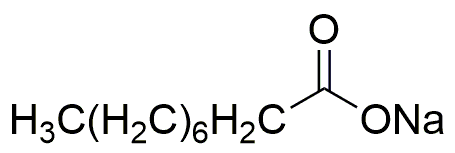Sodium nonanoate is widely utilized in research focused on:
- Food Industry: Used as a food preservative, it helps inhibit the growth of bacteria and fungi, extending the shelf life of products.
- Cosmetics: Acts as an emulsifier and stabilizer in creams and lotions, enhancing texture and consistency while ensuring product stability.
- Pharmaceuticals: Serves as a surfactant in drug formulations, improving the solubility and bioavailability of active ingredients.
- Agriculture: Functions as a biodegradable surfactant in pesticide formulations, improving the spread and adherence of active ingredients on plant surfaces.
- Research Applications: Employed in laboratory settings for various chemical syntheses and as a reagent in organic chemistry, facilitating reactions due to its surfactant properties.
Informations générales
Propriétés
Sécurité et réglementation
Applications
Sodium nonanoate is widely utilized in research focused on:
- Food Industry: Used as a food preservative, it helps inhibit the growth of bacteria and fungi, extending the shelf life of products.
- Cosmetics: Acts as an emulsifier and stabilizer in creams and lotions, enhancing texture and consistency while ensuring product stability.
- Pharmaceuticals: Serves as a surfactant in drug formulations, improving the solubility and bioavailability of active ingredients.
- Agriculture: Functions as a biodegradable surfactant in pesticide formulations, improving the spread and adherence of active ingredients on plant surfaces.
- Research Applications: Employed in laboratory settings for various chemical syntheses and as a reagent in organic chemistry, facilitating reactions due to its surfactant properties.
Documents
Fiches de données de sécurité (FDS)
La FDS fournit des informations de sécurité complètes sur la manipulation, le stockage et l’élimination du produit.
Spécifications du produit (PS)
Le PS fournit une description complète des propriétés du produit, notamment sa composition chimique, son état physique, sa pureté et les exigences de stockage. Il détaille également les plages de qualité acceptables et les applications prévues du produit.
Certificats d'analyse (COA)
Recherchez des certificats d'analyse (COA) en saisissant le numéro de lot du produit. Les numéros de lot et de lot se trouvent sur l'étiquette d'un produit, après les mots « Lot » ou « Lot de fabrication ».
Numéro de catalogue
Numéro de lot/série
Certificats d'origine (COO)
Ce certificat d'exploitation confirme le pays dans lequel le produit a été fabriqué, et détaille également les matériaux et composants utilisés et s'il est issu de sources naturelles, synthétiques ou autres sources spécifiques. Ce certificat peut être requis pour les douanes, le commerce et la conformité réglementaire.
Numéro de catalogue
Numéro de lot/série
Fiches de données de sécurité (FDS)
La FDS fournit des informations de sécurité complètes sur la manipulation, le stockage et l’élimination du produit.
DownloadSpécifications du produit (PS)
Le PS fournit une description complète des propriétés du produit, notamment sa composition chimique, son état physique, sa pureté et les exigences de stockage. Il détaille également les plages de qualité acceptables et les applications prévues du produit.
DownloadCertificats d'analyse (COA)
Recherchez des certificats d'analyse (COA) en saisissant le numéro de lot du produit. Les numéros de lot et de lot se trouvent sur l'étiquette d'un produit, après les mots « Lot » ou « Lot de fabrication ».
Numéro de catalogue
Numéro de lot/série
Certificats d'origine (COO)
Ce certificat d'exploitation confirme le pays dans lequel le produit a été fabriqué, et détaille également les matériaux et composants utilisés et s'il est issu de sources naturelles, synthétiques ou autres sources spécifiques. Ce certificat peut être requis pour les douanes, le commerce et la conformité réglementaire.

